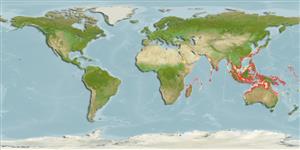Environment: milieu / climate zone / depth range / distribution range
Ecologia
marinhas; estuarina demersal; anfídromo (Ref. 51243); intervalo de profundidade 1 - 40 m (Ref. 3424). Tropical
Indo-West Pacific: coasts of India and Sri Lanka to China; south to Australia.
Length at first maturity / Tamanho / Peso / Idade
Maturity: Lm 18.1 range ? - ? cm
Max length : 18.2 cm FL macho/indeterminado; (Ref. 46605); common length : 11.0 cm TL macho/indeterminado; (Ref. 3424)
Descrição breve
Chaves de identificação | Morfologia | Morfometria
Espinhos dorsais (total) : 8; Raios dorsais moles (total) : 16; Espinhos anais: 3; Raios anais moles: 14. Body silvery; live or fresh specimens with a golden gleam. Head naked; with nuchal spine. Protracted mouth pointing downward. Scales minute. 2nd dorsal spine less than 1/3 of body depth.
Lives in shallow waters down to depths of about 40 m, predominantly near the bottom, found in schools. Feeds mainly on diatoms, copepods, Lucifer, nematodes and polychaetes (Ref. 3424).
Life cycle and mating behavior
Maturities | Reprodução | Spawnings | Egg(s) | Fecundities | Larvas
Kühlmorgen-Hille, G., 1974. Leiognathidae. In W. Fischer and P.J.P. Whitehead (eds.) FAO species identification sheets for fishery purposes. Eastern Indian Ocean (fishing area 57) and Western Central Pacific (fishing area 71). Rome, FAO. Vol. II, pag. var. (Ref. 2108)
Categoria na Lista Vermelha da IUCN (Ref. 130435)
Ameaça para o homem
Harmless
Utilização humana
Pescarias: espécies comerciais
Ferramentas
Relatórios especiais
Descarregue XML
Fontes da internet
Estimates based on models
Preferred temperature (Ref.
123201): 24.6 - 29.2, mean 28.2 °C (based on 1182 cells).
Phylogenetic diversity index (Ref.
82804): PD
50 = 0.5039 [Uniqueness, from 0.5 = low to 2.0 = high].
Bayesian length-weight: a=0.01318 (0.00799 - 0.02176), b=2.99 (2.84 - 3.14), in cm total length, based on LWR estimates for this species & (Sub)family-body (Ref.
93245).
Nível Trófico (Ref.
69278): 3.0 ±0.33 se; based on food items.
Resiliência (Ref.
120179): Elevada, tempo mínimo de duplicação da população menor que 15 meses (K=0.90-1.75).
Fishing Vulnerability (Ref.
59153): Low vulnerability (15 of 100).
